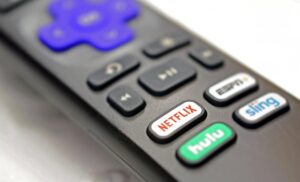Streaming Takes a Wizard

The bonus: being able to stream Amazon programming on my laptop (and later on our flatscreen TV). That temporarily replaced our tradition of watching DVDs from the library.
We had started borrowing videos from the library after Blockbuster’s collapse. We could keep them for a week instead of a day. And, if there weren’t any holds on them, we could renew the loan for another week.
Suddenly, in March 2020,the library closed. For months. When it reopened, for a while the only thing we could do was order a DVD online and pick it up at the drive-up window.
Searching for Programs
While navigating streaming through Amazon proved a bit tricky, we finally learned to use the search function. For an ongoing series, if we paused right before the next installment, later it would pick up where we left off.
Soon after getting Amazon, our cable provider emailed an offer. They would send me a free streaming device, equipped with Peacock and other services.
“Sure,” I said. A couple days later, it showed up in the mail.
Fortunately, we have friends who are more adept with such gizmos. In addition to setting it up, they helped us add our Amazon account to it.
A few months later, another friend showed me how to add the library’s free digital streaming app to my phone.
I also added it to my laptop. Because of multiple headaches with my established library card password, I connected the laptop via my phone’s “temporary” version. I’ve been using it now for nearly two years.
Too Many Choices

I mention Netflix because of a recent story about them losing 200,000 U.S. subscribers in the first quarter. Thact was significant because it was their first viewership loss in a decade.
The streaming service blamed password sharing and the Ukraine-Russia war (which cost it 700,000 Russian customers). But I think the leading reason is the other one Netflix cited: stronger competition.
Or maybe not stronger competition as much as so much competition it’s hard to tell the forest for the trees.
In early 2020, the New York Times ran a story about the number of scripted TV series surpassing 500. That’s aside from game shows, reality shows, sports, and all the other content provided that makes viewing such a jungle.
It’s gotten so bad that I often feel like many streaming services are in effect saying, “We’ll give you these programs for free, as long as you’ll watch these ads.”
Irritating Ads
There are a couple problems with that. One night we watched an installment of a favorite movie series on a “free with ads” channel. The interruptive five-minute blocks were so irritating that we watched the rest on DVDs.
The other challenge for these services is common for all advertising-driven content. When ads come on a streaming service, we either miss them because they’re muted or we’re taking a bathroom break.
The week of its bad news, Netflix mentioned starting a lower-priced option that will require viewers to watch ads. Hope they’re ready for millions of mute buttons going into action.


